Years active 1994–present | Website theaquabats.com | |
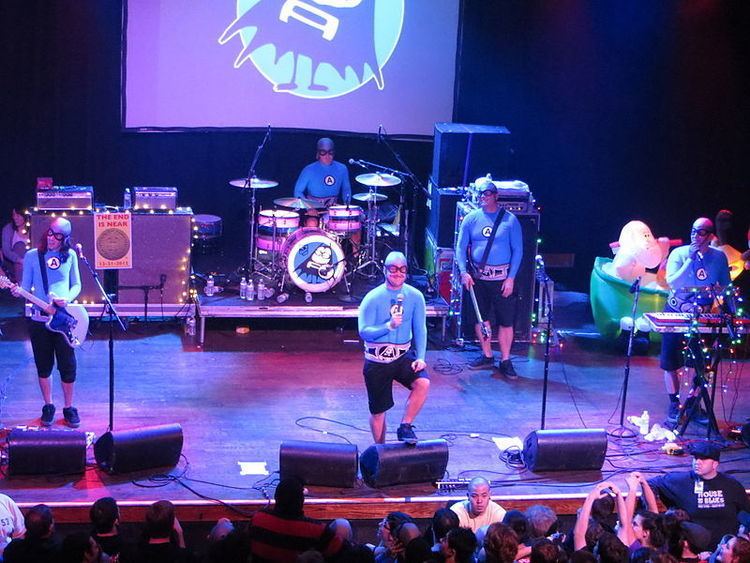 | ||
Labels Horchata, Goldenvoice, Fearless, Nitro Associated acts Bad Credit, Bikeride, Blink-182, Digital Unicorn, DJ Lance Rock, GOGO13, The Goodwin Club, Moon Monkeys, The Sandfleas, Supernova, Gerard Way Past members See: The Aquabats former members Origin Huntington Beach, California, United States (1994) Members Christian Jacobs, Ian Fowles, Richard Falomir Genres Rock music, New wave, Pop punk, Ska Albums The Fury of The Aquabats!, The Aquabats vs the Fl, Hi‑Five Soup!, The Return of The Aquabats, Myths - Legends and Other Profiles | ||
The aquabats vs the rockafire explosion
The Aquabats are an American rock band formed in Orange County, California in 1994. Throughout many fluctuations in the group's line-up, singer The MC Bat Commander and bassist Crash McLarson have remained the band's two constant fixtures. Since 2006, The Aquabats' members also include keyboardist Jimmy the Robot, drummer Ricky Fitness and guitarist Eagle "Bones" Falconhawk.
Contents
- The aquabats vs the rockafire explosion
- The aquabats red sweater
- Formation
- 19941996 Early years
- 19971998 The Fury of The Aquabats and mainstream breakthrough
- 19992004 Change in genre career decline and semi hiatus
- 20052009 Charge and renewed success
- 20102013 Hi Five Soup and The Aquabats Super Show
- 2014 present 20th anniversary and beyond
- Musical style
- Departure from ska genre
- Live performances
- Superhero mythology
- The Aquabats Cadet Faction and Cadet Summits
- Side bands and related projects
- Discography
- Current
- Former
- Songs
- References
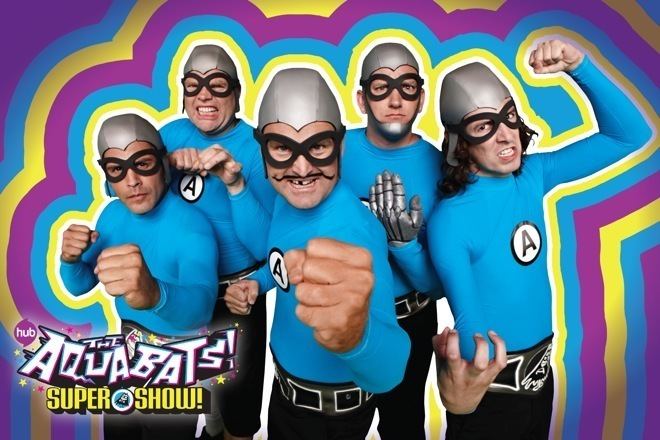
Easily identified by their masks and matching costumes, The Aquabats are perhaps most recognized for their comedic persona in which they claim to be crime-fighting superheroes. This theme serves as subject for much of the band's music and as part of their theatrical stage shows, which typically feature various stunts and fight scenes with costumed villains and monsters. Musically, The Aquabats have continuously evolved over the course of their career, starting as an eight-member ska band before reinventing themselves in the early 2000s as a new wave-influenced rock quintet. The band's current musical style mixes rock and punk with elements of new wave, ska and synthpop.
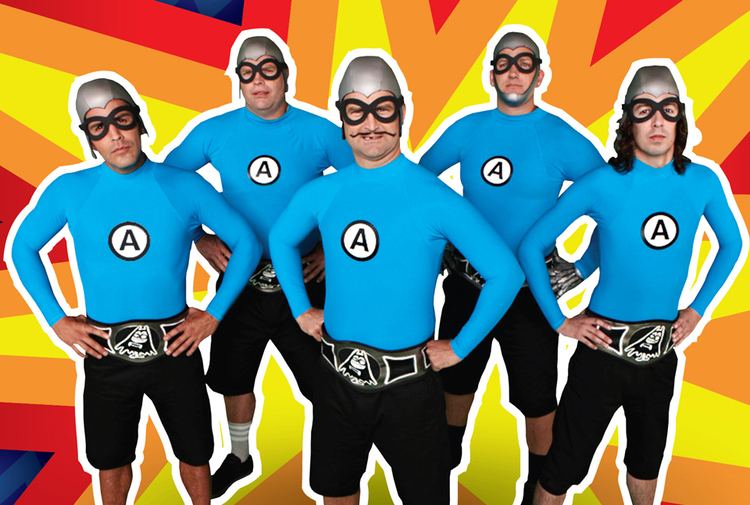
The Aquabats have released five studio albums, two extended plays and one compilation, among other recordings. From 2012 to 2014, the band also created and starred in The Aquabats! Super Show!, a live-action musical action-comedy television series which aired on American cable channel The Hub. The series ran for three seasons, earning a total of eight Daytime Emmy Award nominations and ultimately winning one.
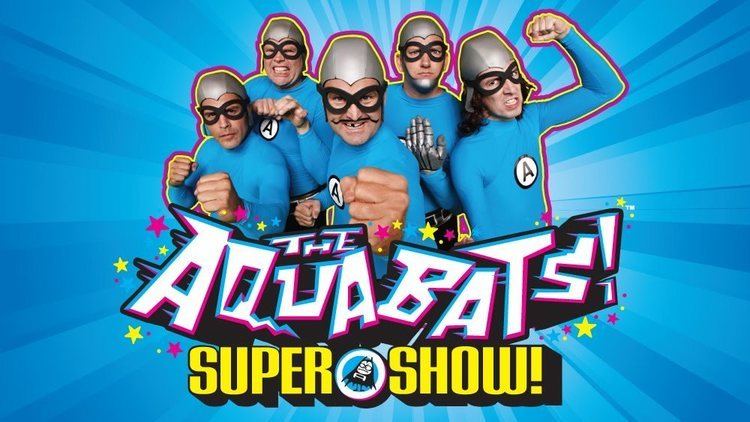
The aquabats red sweater
Formation
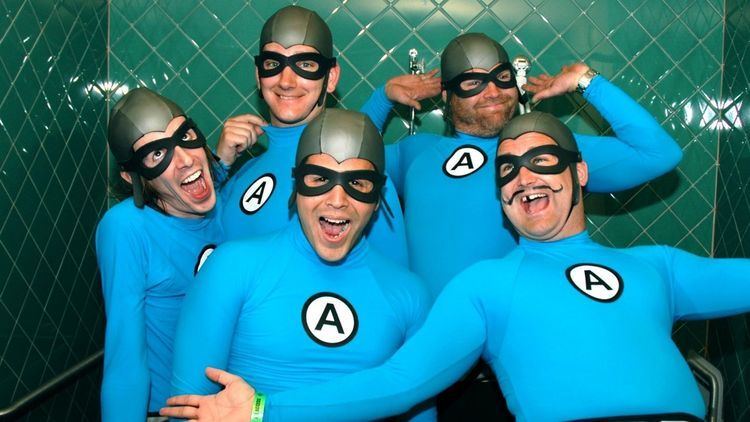
In the early 1990s, musicians Christian Jacobs, Chad Larson and Boyd Terry met and befriended each other while living in Brea, California. Having all been active in various local punk and alternative rock bands, the three eventually conceived the idea of forming a joke band satirizing the Orange County punk scene, which Jacobs described at the time as being overwhelmed with "testosterone, beer and people fighting". The concept was to start an unabashedly silly punk band as a complete antithesis to the genre's more aggressive and humorless bands, with the intention of performing at punk shows to poke fun at the scene. While later attending a ska show in Orange County, Jacobs was exposed to the area's burgeoning ska scene and was impressed by its ethos: as he recalled, "No one was fighting or pushing each other but having a good time". It was then decided that they would start a ska band instead, "to be part of the fun".
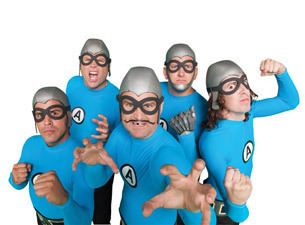
With Jacobs assuming vocal duties, Larson on bass guitar and Terry on trumpet, the trio recruited several more musician friends from other local bands to piece together a full ensemble. Each member of the original line-up had musical backgrounds in various genres, including ska, punk, surf and new wave, all elements which were incorporated into the band's music and aesthetic: for example, the name "The Aquabats" was created to sound like a classic surf band, while a shared admiration of Devo inspired the idea of matching costumes. Jacobs simply recalled in a 2013 interview, "We wanted to combine Devo with surf music and ska". Rehearsing only once in a house Jacobs and Larson shared at the time, The Aquabats played their first show a mere week after forming at a house party in August 1994. Larson remembered this show as merely "a joke...we weren't trying to be a band. We were trying to have fun". Nevertheless, encouraged by a positive audience reception, The Aquabats started performing more local shows, soon becoming familiar faces within the Orange County underground.
1994–1996: Early years
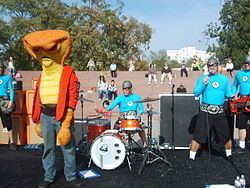
With professionalism far from foremost concern, The Aquabats' earliest band line-ups changed with almost every concert, occasionally featuring as many as twelve to fourteen musicians at a time onstage, with the majority typically playing brass instruments. As they gradually developed a steady following and began playing shows with more regularity, the band settled into a tighter and more manageable unit consisting of around eight to nine musicians, filled out by a horn section, two guitarists and a keyboardist. It was with this type of line-up that The Aquabats began recording, independently producing the demo tapes The Revenge of the Midget Punchers in 1994 and Bat Boy in 1995.

Initially, The Aquabats intended to make each of their performances unique by wearing a different set of matching costumes for every concert, ranging from chef's uniforms to grass skirts and fezzes, all with an individual persona — during one show wearing chef outfits, for instance, the band hosted an actual onstage barbecue. When the group's props and get-ups soon became more cumbersome to transport than their musical equipment, it was ultimately decided a singular costume was required. Terry, a future apparel designer who was employed by the wetsuit manufacturing company Aleeda at the time, acquired a large amount of spare rubber and neoprene and fashioned together a set of helmets and rashguards for the band members. The addition of customized vinyl belts, donated to the band by then-unknown artist Paul Frank, effectively completed the style The Aquabats would maintain for the rest of their career.
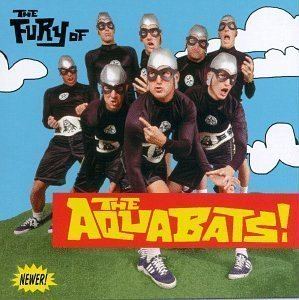
To accompany their distinct new uniforms, The Aquabats constructed a backstory which alleged they were actually superheroes hailing from the distant island of "Aquabania", though Larson admits the entire mythology was simply made up piece by piece as they went along from one interviewer to the next. As their mythology grew, the members soon adopted superhero stage names and identities, and began tailoring their live shows around a comic book aesthetic by incorporating onstage stunts and mock battles with costumed villains, antics which were originally ploys to get the band's friends into shows for free. Jacobs' brothers Parker and Tyler, a cartoonist and graphic artist, respectively, were brought in to help develop the band's cartoon-influenced visual style, designing their logos and promotional material as well as playing characters in The Aquabats' stage shows and mythology.
In 1996, The Aquabats independently produced and recorded their debut album, The Return of The Aquabats, pressing the CDs themselves. Having already amassed a sizable cult following for their increasingly eccentric live shows, the band managed to sell a respectable 20,000 copies of their album without any marketing or distribution. With the growing mainstream popularity of ska music, The Aquabats quickly rose to prominence within Orange County's booming ska scene, regularly touring alongside the likes of such commercially successful bands as No Doubt, Sublime and Reel Big Fish and bringing them to the brink of achieving mainstream recognition.
1997–1998: The Fury of The Aquabats! and mainstream breakthrough
By late 1996, propelled by the multi-platinum success of No Doubt and Sublime, ska had broken through into the American mainstream to become one of the most popular forms of alternative music. With record labels now turning their attention towards ska bands, The Aquabats were promptly signed to Goldenvoice Records and released their second album The Fury of The Aquabats! in October 1997 through Time Bomb Recordings. While still predominantly a ska album, The Fury showcased a more ambitious musical streak than The Return, incorporating stronger elements of punk and surf, as well as featuring instrumentals, parodies of ragtime and tango music, and a variety of unconventional instruments including sousaphones and banjos. Released at the commercial height of the American ska revival, The Fury soon became The Aquabats' most successful album to date, peaking at number 172 on the Billboard 200 and number 12 on its Top Heatseekers, while lead single "Super Rad!" found regular airplay on MTV and Los Angeles' influential KROQ-FM. On July 25, 1998, they fought the alien rock band GWAR during The Ska Parade.
The Aquabats spent 1997 and 1998 touring extensively behind The Fury, carrying out both supporting and headlining tours of the United States and traveling internationally as part of the 1998 Warped Tour. By this time, the band had settled into a stable touring line-up of Jacobs (The Bat Commander), Larson (Crash McLarson), Terry (Catboy), drummer Travis Barker (The Baron Von Tito), guitarists Charles Gray (Ultra Kyu) and Courtney Pollock (Chainsaw, the Prince of Karate), trumpeter Adam Deibert (Prince Adam) and keyboardist/saxophonist James Briggs (Jaime the Robot, later Jimmy the Robot). This line-up would last The Aquabats up until 1998, when, in the middle of a tour with pop punk trio Blink-182, Blink unexpectedly fired their drummer Scott Raynor and recruited Barker as a last-minute replacement to sit in for the rest of the tour. By the tour's close, the band was so impressed with Barker's performance that they invited him to join Blink-182 as a full-time member, an offer which Barker accepted, amicably parting ways with The Aquabats. Barker was succeeded by Gabe Palmer (Doctor Rock), solidifying a line-up which would last the remainder of the decade.
With the band now finding enough success to generate both an adequate income and media visibility, Jacobs — a former child actor with ties in the entertainment industry — began to conceive the idea of adapting The Aquabats' superhero mythology into a television series. After pitching the concept to several networks, Buena Vista Television eventually agreed to help produce a short live-action pilot in 1998, directed by comedian Bobcat Goldthwait. Titled simply The Aquabats!, the pilot followed the fictional misadventures of the eight band members in an intentionally campy style similar to Saturday morning cartoon shows. The pilot, which has yet to be made available for public viewing, failed to attract any network interest and was later openly disowned by the band themselves.
1999–2004: Change in genre, career decline and semi-hiatus
By the time The Aquabats began writing new material for their next studio album in 1998, the group had begun to feel pigeonholed by their public status as a "cheesy ska band" and consciously decided to start exploring more diverse musical styles rather than merely returning to a ska-based sound. As such, the band's third album, The Aquabats vs. the Floating Eye of Death!, marked an abrupt stylistic shift, completely abandoning the ska rhythms which dominated their previous albums in favor of more punk and new wave-influenced textures, emphasizing guitar and synthesizer-driven melodies over brass and woodwinds. With the total absence of The Aquabats' formerly marketable ska sound, Goldenvoice expressed mixed feelings over Floating Eye, reportedly telling the band that the album had no potential single material and would be difficult to promote. In a 2005 interview, Larson retrospectively lamented upon Floating Eye's lack of a commercial sound, noting that while he and the band felt the material was strong, it "probably wasn't the record we should have put out at that time".
True to their predictions, Floating Eye failed to match the commercial success of its predecessor, charting only at a mere 35 on Billboard's Top Heatseekers. Despite the album's underwhelming performance, Goldenvoice nevertheless granted The Aquabats a small budget for a music video, which the band instead used to independently film a five-minute promotional video as another prospective television pilot, The Aquabats! In Color!, an action-oriented series styled similarly to Japanese tokusatsu shows. Despite potential interest from the Fox Family Channel prior to their acquisition by Disney which cancelled all development deals, the pilot again failed to generate any interest, bringing The Aquabats' career to a standstill.
Following the huge financial losses Goldenvoice suffered from the inaugural Coachella Valley Music and Arts Festival in 1999, the company was eventually forced to cease operations, leaving the Aquabats without a record label. After an unsuccessful search for a new label, the band eventually turned to the Internet to independently manage and promote themselves while the members resumed their day jobs to continue funding the band. Jacobs likened the experience to a superhero's alter ego, working by day and fighting crime [read: being an Aquabat] by night. While The Aquabats could not secure a proper recording contract, the band did negotiate a distribution deal with Fearless Records, releasing a collection of outtakes and demos from the Floating Eye sessions entitled Myths, Legends, and Other Amazing Adventures, Vol. 2 before slipping back into a period of relative inactivity.
With a lack of label support leaving the band to finance themselves entirely out of pocket, The Aquabats indefinitely postponed all plans for future recording or extensive touring, limiting their activity primarily to sporadic shows in the southwest United States. The loss of touring income, coupled with the band members' return to their jobs and families, eventually contributed to the departure of several key members: in 2000, guitarist Gray left the band, followed by Palmer and co-founder Terry in 2002. To avoid the financial constraints of hiring two new members, Adam Deibert assumed a dual role as trumpeter and guitarist for the band's live shows, while Palmer was replaced by former Assorted Jelly Beans drummer Ricky Falomir (Ricky Fitness). With this more stable and compact line-up, The Aquabats returned to the studio to record original music for Evan Dorkin's Welcome to Eltingville, a 2002 animated television pilot which aired on Adult Swim but was ultimately not picked up as a series. The following year, the band would release their first DVD, Serious Awesomeness!, featuring a full live performance filmed in Pomona, California and numerous clips spanning their entire career.
In 2004, with almost five years passed since having released any official studio material, The Aquabats independently recorded and released the five-track EP Yo! Check Out This Ride! as an attempt to both satisfy the band's fanbase and serve as a potential demo to attract interest from record labels. As their first recording with only six members and no use of a horn section, Yo! Check Out This Ride! marked the most drastic shift yet in The Aquabats' sound, taking the band even further into keyboard-driven rock and new wave-influenced songwriting. This would also mark Deibert's final recording with the band, as he would officially retire from the group later in the year, reducing The Aquabats to a quintet.
2005–2009: Charge!! and renewed success
In the summer of 2004, The Aquabats were signed to independent label Nitro Records and began work on a new studio album in the fall. Despite this fortuitous turn of events, the group were still uncertain of their future following their semi-hiatus and radical shift in line-up; Jacobs later admitted that the band spent the recording sessions under the belief that it could possibly be their last album. After several months of production and much online hype, The Aquabats released their fourth album Charge!! on July 7, 2005. Continuing with the direction set by Yo! Check Out This Ride!, Charge!! was a bold introduction to The Aquabats' new musical style of guitar-driven, new wave-influenced rock.
Released to a largely positive critical reception with many critics praising the band's shift in genre, Charge!! effectively revitalized The Aquabats' career as the band recommitted themselves to regular touring. Days after the album's release, The Aquabats headlined a successful 34-city tour of the United States with similarly theatrical bands The Epoxies and The Phenomenauts, followed by tours of the United Kingdom and Japan, the latter supporting Nitro Records founders The Offspring. On September 23, 2005, The Aquabats made their national television debut on the G4 program Attack of the Show, performing Charge!!'s lead single, "Fashion Zombies!".
While the following year would present even more lucrative touring opportunities for The Aquabats, the band's renewed success would also have its drawbacks. In May 2006, it was announced that guitarist Pollock had reluctantly departed the group after 12 years, claiming the band's increased touring activity was conflicting with his business schedule. Pollock was succeeded by former Death by Stereo member Ian Fowles (Eagle "Bones" Falconhawk), though he would continue to contribute guitar tracks to The Aquabats' studio albums and perform with the band as a second guitarist for their southern California concerts and major festival shows. After releasing a limited-print tongue-in-cheek "One Year Anniversary Edition" of Charge!!, The Aquabats carried out another national tour before announcing a brief hiatus in January 2007 to focus on writing their next album.
During this period, Jacobs had been pursuing a career in television production with his creative partner and longtime Aquabats collaborator Scott Schultz, independently filming prospective pilots for family television shows. In 2007, Jacobs and Schultz successfully sold one of their pilots, a preschooler show called Yo Gabba Gabba!, to Viacom's Nick Jr. channel. As a musically-oriented program, Yo Gabba Gabba! featured several guest appearances by The Aquabats, appearing onscreen performing both old and new songs and starring in various sketches. The series went on to become an award-winning international sensation, bringing a generous amount of media attention towards both Jacobs and The Aquabats, just enough to persuade Gabba's production company Wild Brain to help produce a new pilot again based on the band.
Shot on location throughout California in early 2008, The Aquabats' third television pilot, titled The Aquabats! Super Show!, was a fully realized half-hour episode featuring both live-action and animated storylines starring and featuring original music by the band. The Aquabats spent the remainder of 2008 heavily promoting the Super Show! pilot through extensive viral advertising and further touring, including appearances at the 2008 San Diego Comic-Con International, where the pilot was publicly debuted for fans, high-profile festivals including the Bamboozle Left and Groezrock in April 2009, and opening for Blink-182 on two dates of their 2009 reunion tour.
Though The Aquabats continued to be a popular touring draw, the band experienced a tumultuous period of pre-production on their proposed fifth studio album lasting for nearly two years. Though a July 2007 news update announced that preliminary recording had already begun, no new material ever surfaced from these sessions or was ever performed live. As the band resumed touring throughout the United States and Europe, fewer updates were reported on the album's progress until all plans were abruptly ceased in April 2009, when The Aquabats were dropped from Nitro Records due to "trying economic times and a struggling musical landscape", according to Jacobs. With a glum confirmation of "no record company, no record", The Aquabats' future seemed once again shadowed in doubt.
2010–2013: Hi-Five Soup! and The Aquabats! Super Show!
Despite the lack of a record label, The Aquabats continued to tour internationally throughout 2010 and 2011, headlining tours of the United States and the United Kingdom, as well as appearing at the 2010 Soundwave festival in Australia — the band's first ever visit to the continent. In August 2010, The Aquabats suddenly announced plans on their website that they would be independently releasing their next studio album in November of that year. However, following a last-minute distribution deal with Fearless Records, the album's release date was postponed to 2011 to provide for proper marketing and promotion, and an EP containing its first single, Radio Down!, was released in its place. Hi-Five Soup!, The Aquabats' fifth full-length album, was released on January 18, 2011, becoming the band's highest-charting album since The Fury, debuting at number 181 on the Billboard 200 and number 5 on Top Heatseekers. In promotion of the album, the band embarked on a 21-city national tour supporting Reel Big Fish, followed by a performance at the 2011 Coachella Valley Music and Arts Festival.
On March 24, 2011, it was formally announced via press release that The Aquabats! Super Show! had been acquired as a series by family cable channel The Hub, a joint venture between Hasbro and Discovery which launched in 2010 as a replacement for Discovery Kids. Created and produced by Jacobs, Schultz and Jason deVilliers, the series followed the fictionalized adventures of The Aquabats in a deliberately campy style inspired by the 1960s Batman TV series, mixing live-action storylines with cartoon shorts, parody commercials and musical interludes featuring new original music and songs written and performed by the band.
After spending the majority of 2011 in production, the first season of The Aquabats! Super Show! ran for thirteen episodes from March 3, 2012 to June 16, 2012, meeting with a largely positive critical reception and consistently high ratings for the modestly-sized channel, eventually earning a Daytime Emmy nomination for Outstanding Children's Series, which it ultimately lost to fellow Hub series R. L. Stine's The Haunting Hour. In October 2012, production began on the series' second season, which premiered on June 1, 2013 with a short run of five episodes. The following October, three additional episodes were filmed, though The Hub later explicitly referred to these episodes as "specials" rather than a continuation of season two. These three specials aired from December 21, 2013, to January 14, 2014.
2014-present: 20th anniversary and beyond
Since the 2012 premiere of The Aquabats! Super Show!, The Aquabats largely cut back on extensive touring in order to accommodate their television production schedule, once again limiting their live shows to occasional performances within the Southwestern United States. In April 2013, the band carried out a six-show tour of Europe and the United Kingdom, concluding with an appearance at the Groezrock punk rock festival in Belgium. The following June, The Aquabats were once again featured on the Warped Tour, though only played eight shows in the Southwest region. Despite playing a limited portion of the tour, the band were regularly featured on the second season of Fuse's Warped Roadies, a reality series documenting the road crew of the Warped Tour, where they were most notably the subject of one episode in which they incur the wrath of a stage manager for repeatedly playing over their set times.
On March 17, 2014, in celebration of their 20th anniversary as a band, The Aquabats announced the first leg of their "20th Anniversary Tour" for May, their first extensive headlining United States tour in years, covering fifteen shows in nine states on the East Coast. The following July, the band carried out five more dates across California, Washington and Oregon, then announced eleven more dates covering six states across the western half of the country.
In a Huffington Post feature on the band prior to the 2014 San Diego Comic-Con, Jacobs revealed that The Hub had opted not to renew The Aquabats! Super Show! for another season following extensive network rebranding by Hasbro and Discovery, effectively canceling the series. Jacobs admitted he was surprised by this turn of events, noting "Everything we heard was that the show has been a real Cinderella story for the Hub and that it was rating really well with viewers. We just assumed that we'd eventually go back into production or at least get picked up for Season 3", but ultimately concluded "it is what it is" in regard to the network's decision. Despite this, Jacobs remained optimistic about the series' future, saying "Given that we now live in a world where people are streaming TV shows directly onto their iPhones & computers, and given that companies like Netflix & Yahoo! are now picking up so much new content for their customers...I just find it hard to believe that The Aquabats! Super Show! is really over. I mean, we haven't even made any toys yet". He concluded by stating "It took us almost 15 years to get that TV series made. And even though we've got a bunch more concert dates lined up for the rest of this year, our first priority is to find a new home for The Aquabats! Super Show!".
Musical style
Over the course of their two decades-long career, The Aquabats have experienced several radical evolutions in their sound and musical style.
Having originally formed as a part of Orange County's burgeoning third wave ska scene, much of the band's early material was rooted in the genre. Boasting an eight-piece line-up featuring two lead guitarists, a keyboardist and a horn section consisting of two trumpets and a saxophone, The Aquabats' style of ska was primarily driven by brass and guitar, incorporating elements of surf rock and punk rock. Their second album, 1997's The Fury of The Aquabats!, while still predominantly ska-based, found the band starting to expand their sound into newer territory, featuring more pronounced punk and surf influences and tongue-in-cheek experimentalism, including several instrumentals, pastiches of ragtime and tango music and the utilization of such unconventional instruments as clarinets, electric sitars and even manualism.
In 1999, The Aquabats underwent a significant shift in style for their third studio album The Aquabats vs. the Floating Eye of Death! and its companion piece Myths, Legends, and Other Amazing Adventures, Vol. 2, further exploring the multi-genre eclecticism which had been hinted at with The Fury. A conscious decision by the band to write more diverse material, these albums saw a near-complete forfeit of the brass-driven ska of their previous albums in favor of more guitar and synthesizer-structured songwriting, embracing a punk rock and new wave sound greatly influenced by Devo and Oingo Boingo, two of The Aquabats' biggest inspirations. The band also began widening their genre experimentation to encompass such disparate styles as electronica, synthpop and even hip-hop, elements which persist in their sound to present day.
During The Aquabats' career lull in the early 2000s, several of the band's key members departed from the line-up, eventually reducing the former octet down to a mere quintet of vocals, guitar, keyboards, bass, and drums. This inevitably had a profound impact on The Aquabats' sound, in particular the complete loss of their once characteristic horn section. 2005's Charge!!, the first release featuring this reduced line-up, marked an abrupt shift from the eclecticism of their previous records, firmly establishing The Aquabats' current rock-based musical style, mixing elements of punk, new wave and ska. In recent years, The Aquabats have introduced an increased presence of keyboards and synthesizers into this style, with critics noting their 2011 album Hi-Five Soup! as featuring more noticeable elements of synthpop and electronica.
Departure from ska genre
Although the band continues to incorporate occasional elements of ska into their music, The Aquabats have since distanced themselves from their association with the ska genre after having moved away from an overtly ska-based sound in the early 2000s, having since labeled themselves as simply a "rock band" in their official press biographies. In a 2012 interview, singer Christian Jacobs stated "I don't think we ever considered ourselves a ska band. We were just The Aquabats. And some of the songs we happened to play were ska", noting elsewhere, "It was never a deliberate thing [to stop playing ska], but I think it just naturally happened because there's a lot of different styles of music that we play. I've always been into bands like Ween and things like that, that can chameleon-like drift from genre to genre and play whatever music they want...there's no boundaries. If you set yourself up as a punk band, then you pretty much just have to play punk. Or if you're a ska band, you just play ska". Chad Larson, speaking on the same matter, explained "Having the same guitar rhythm for every song gets kind of boring...even on the earlier albums that had ska rhythms we were focusing more on the 'adventure' songs than really 'ska' songs. So as we grew as musicians, we wanted to experiment with different rhythms", adding "we were never really a good ska band anyway".
Live performances
Since the earliest days of the band, The Aquabats have earned a reputation for their theatrical live performances featuring a variety of comedic stunts and antics based around their superhero-themed persona.
During the 1990s, when their concerts were at their most elaborately staged, a typical Aquabats performance would often include choreographed fight scenes with costumed villains, the use of numerous props, acrobatic stunts and varying degrees of pyrotechnics, ranging from small fireworks to The MC Bat Commander fire breathing. While many of these elements were eventually phased out of the live shows in the early 2000s, the one consistent staple of every Aquabats concert has remained the band's onstage "battles" with villains and monsters. These villains, typically played by The Aquabats' road crew, will crash the stage at one or two moments in the show and exchange humorous banter with the band before engaging each other in mock combat. These fights have ranged from short, improvised fistfights to fully choreographed stage combat utilizing breakable props, maneuvers such as flying kicks and back flips, and sometimes spreading out into the audience, with The Aquabats ultimately winning most—but not all—encounters. For some performances, in place of a villain, The Aquabats will feature a sketch with one of their "allies": for example, to segue into their song "Magic Chicken", the titular character— a man in a chicken suit— will come onstage to hand out fried chicken to audience members.
Audience participation is a common element of The Aquabats' stage shows. Both the band and their onstage characters regularly interact with the crowd, including initiating mass games of beach ball volleyball or spraying them with substances like Silly String and fire extinguishers. Additionally, a few of The Aquabats' enemies are known only to be "defeated" by fans by being pelted with projectiles supplied by the band, usually large quantities of plastic balls. Acknowledging the younger members of their fanbase, The Aquabats often incorporate any children in the venue as part of their shows, inviting them to dance onstage with the band at the end of their sets. With parents' permission, children can also take part in onstage games and activities with the aid of the audience. The most common of these have included "pool floatie races", where two selected children mount inflatable rafts or pool toys and race across the venue via crowd surfing, and assisted stage diving, in which between songs the MC Bat Commander will gently throw children into a waiting audience so they may experience their "first punk rock moment".
On the visual end of these performances, keeping in line with their cartoon and pop culture-inspired aesthetic, The Aquabats' stage shows are accompanied by a large video screen backdrop which plays montage clips of various cartoons, movies, TV shows, and stock footage specifically edited to match each song. This screen also plays prerecorded comedy videos starring the band which introduce and close each show, as well as fake commercials for fictional Aquabats-brand products which serve as impromptu "commercial breaks" between songs. These visuals, along with the band's props and costumes, are regularly changed to accommodate special seasonal performances, in particular The Aquabats' annual holiday shows.
Superhero mythology
Perhaps even more so than for their music, The Aquabats are widely recognized for their eccentric superhero identity which adheres to a comprehensive mythology in which the members are in fact a team of musical crimefighters on a quest to save the world, their stories have been reflected in the band's music, costumes, stage shows and promotional material for the entirety of their professional career.
Detailed in their lyrics, liner notes, website and television series, The Aquabats have developed a small but elaborate fictional universe surrounding this mythology, describing the band's fictitious history and outlandish adventures as well as conceiving an extensive roster of enemies and allies, many of whom are the subjects of specific songs and have appeared as part of The Aquabats' stage shows in mock fight scenes or comedic skits. Over the years, this mythology, and in particular the fictional backstory regarding their origins, has continually changed, evolved and occasionally been retconned to explain changes in the band's line-up.
The Aquabats' origin story can be separated into two distinct eras. For the first half of their career, the band maintained a consistently canonical backstory established over the course of their first two albums, alleging the band members were actually humanoid bat creatures hailing from a distant tropical island called "Aquabania". According to legend, Aquabania had been invaded by the villainous Space Monster "M", forcing the surviving inhabitants to flee into the ocean where they eventually washed ashore in California and were taken in by Professor Monty Corndog, a mad scientist who used "chemicals" to give them superpowers. Donning costumes including such accessories as "radioactive rashguards", "power belts", and "anti-negativity helmets", The Aquabats chose to channel their powers through music in order to "take over the world" by attracting legions of fans to aid them in combating Space Monster "M" and reclaiming their homeland, fighting the numerous villains and monsters who'd attempt to thwart their musical quest along the way.
With the heavy line-up changes in the early-to-mid 2000s which left only two of the original members remaining, The Aquabats eventually dropped the Aquabania elements out of their backstory, reestablishing themselves as a group of freelance superheroes of indeterminate origin who travel the countryside, fighting evil and "destroying boredom". This loose framework would later serve as the basis for the band's television series, The Aquabats! Super Show!, where each member's character was further developed to showcase their own individual powers and personalities, transitioning the Aquabats' mythology from a story arc to a character ensemble. While the series' first season left the band's origins intentionally vague, several episodes of the second season feature each member of The Aquabats recounting the band's history in animated flashback sequences; while one of these sequences recalls the original Aquabania mythos, each member's flashbacks directly contradict one another, leaving it unknown which could be considered officially canonical.
The Aquabats Cadet Faction and Cadet Summits
The Aquabats Cadet Faction is the official fan club of the band, and its members are commonly referred to as Aquacadets. While the benefits of enrollment are regularly updated with each re-issuing of the membership packages, Aquacadets are usually allowed access to exclusive merchandise, an official newsletter, a personalized ID card and entrance to semi-annual fan conventions known as Cadet Summits. These Summits are held in southern California and typically include meet and greets and Q&A panels with the band, games, door prizes, Cadet award shows (including "Cadet of the Year") and live performances by The Aquabats and their related side projects. The following is a list of the five Cadet Summits which have been held over the years and their respective highlights:
Fans are encouraged to attend these events and the band's concerts in costume. These costumes often include official items that are available as part of the band's merchandise catalog, but also consist of homemade and personalized outfits, a practice The Aquabats actively encourage and sometimes award at Cadet Summits. Some fans have also independently formed splinter factions of the Aquacadets such as the "Astrobats", "Piratebats" and "Ninjabats", outfitting themselves with accordingly themed customized apparel to show their support for the band.
Among The Aquabats' many cadets is Reel Big Fish lead singer Aaron Barrett, who can be seen wearing a vintage fan club patch in the music video for Reel Big Fish's "Party Down".
Side bands and related projects
The roots of The Aquabats are usually traced back to GOGO13, a comic ska band founded by Christian Jacobs' brothers Parker and Tyler while they were living in St. George, Utah in 1993. Following their abrupt disbandment in 1994, several of GOGO13's members moved on to play in The Aquabats' earliest line-ups, during which time the band's performances consisted of several GOGO13 songs, most notably "Idiot Box!", which was later recorded for The Aquabats' first two albums. Parker Jacobs permanently reformed GOGO13 in 2001 and continues to tour with a rotating line-up of musicians which, among others, have included original Aquabats trumpeter Boyd Terry and guitarist Ben "The Brain" Bergeson.
From 1993 to 1995, Adam Deibert, Charles Gray, Corey Pollock and Pat "Patbat" McDonald were all members of the Huntington Beach ska band The Goodwin Club, recording only one full-length album before disbanding in April 1995, playing their final show opening for The Aquabats. Deibert, Pollock and McDonald were later involved in a one-off Goodwin Club reunion show in September 2015, which featured a guest appearance by Christian Jacobs in character as the MC Bat Commander. Prior to forming The Aquabats, Christian Jacobs sang in a shoegazing duo called The Moon Men with future Aquabats and Yo Gabba Gabba! collaborator Scott Schultz, while Chad Larson was the bass guitarist for the hardcore punk band B.H.R. until their break-up in 1997.
In 1997, Parker Jacobs formed The Sandfleas as a side project to perform as openers at The Aquabats' shows, based on the gang of masked villains who had become a staple of The Aquabats' mythology and onstage rogues' gallery. Consisting anonymously of Parker Jacobs on vocals and a rotating line-up of musicians including Christian and Tyler Jacobs, Larson and Pollock, The Sandfleas played deliberately sloppy punk rock songs which were humorously antagonistic and insulting towards their audience, intending to be the musical "bad guy" equivalent to The Aquabats' "good guys". The Sandfleas released an EP entitled Four Songs Four Jerks on The Aquabats' Horchata Records label in 1999 before breaking up shortly afterwards.
During their time in The Aquabats, Deibert and Gray both joined the Long Beach indie pop band Bikeride in 1999 as bassist and guitarist, respectively, recording on three of the band's studio albums, all of which featured James Briggs' guest contributions on saxophone and clarinet. Gray left Bikeride in 2002, though Deibert remained a member until lead singer-songwriter Tony Carbone's death from cancer in 2008. Shortly before Carbone's death, The Aquabats hosted a benefit show for Carbone in Pomona, California, where Deibert joined the band onstage during their encores. From 1999 to 2010, Deibert was also active in the two-man electronic project Digital Unicorn, which he had originally created as a last-minute replacement for an opening band who had dropped off a tour with The Aquabats. Digital Unicorn eventually progressed into a solo endeavor, culminating in the studio album Theirs Travel Began and Loaded the Dream, which was released on Horchata Records in 2001.
After leaving The Aquabats in 1996, Ben Bergeson founded the instrumental surf rock band The Moon Monkeys, playing numerous shows with The Aquabats and GOGO13 before releasing their sole studio EP So Far, Far Out! in 1999 on Horchata Records. Corey Pollock, following his own departure from The Aquabats in 2006, joined the Costa Mesa pop punk trio and longtime Aquabats tourmates Supernova in August 2008, playing with them under his Aquabat stage name of "Chainsaw" until their hiatus in January 2010.
As professional musicians, current guitarist Ian Fowles and drummer Ricky Falomir have performed and recorded with many bands and musicians of note, though are best known as original members of the punk rock bands Death by Stereo and Assorted Jelly Beans, respectively. In relation to The Aquabats, Fowles was a guest bassist for Hunter Burgan's Hunter Revenge and - in costume as EagleBones - Kepi Ghoulie's band during both groups' tours with The Aquabats, and in 2014, became an official member of My Chemical Romance singer Gerard Way's solo band after the two had become acquainted working together on The Aquabats! Super Show!, recording and co-writing on Way's 2014 debut Hesitant Alien. In June 2015, both Fowles and Falomir made up ex-Ramones bassist C. J. Ramone's backing band for an East Coast tour with Japanese band Shonen Knife.
Along with Parry Gripp, the band re-recorded their song "Sequence Erase" as an instrumental for Mega64 as the series' theme song.
Discography
Current
Former
Songs
Super Rad!The Fury of The Aquabats! · 1997
Fashion Zombies!Charge!! · 2005
Martian Girl!The Return of The Aquabats · 1996
